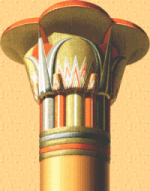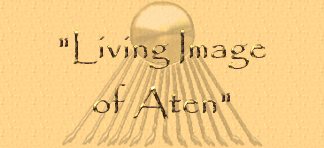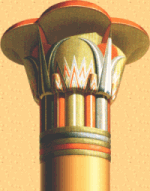 |


 Undoubtedly the image most often envisioned when one thinks or hears of Tutankhamun is that of his golden funeral mask. Reflected in the burnished contours, outlined with countless inlays, is a vision of a Pharaoh who, despite his youth, is secure in his power whilst modestly aware that he governs the most bountiful nation in the ancient world. This is Tutankhamun as he wished to be seen before the gods, the "Living Image of Amun." But the glitter of the golden mask often overshadows another portrayal with which it shared the same tomb and subject. All of 30 cm tall and carved from wood, gessoed and painted, the sculpture captures Tutankhamun's youthful head emerging from a lotus blossom, his elongated skull tapering back from the cherubic roundness of his face. Here we are presented not with a king, but a boy, a prince. This is Tutankhaten, "Living Image of Aten."
Undoubtedly the image most often envisioned when one thinks or hears of Tutankhamun is that of his golden funeral mask. Reflected in the burnished contours, outlined with countless inlays, is a vision of a Pharaoh who, despite his youth, is secure in his power whilst modestly aware that he governs the most bountiful nation in the ancient world. This is Tutankhamun as he wished to be seen before the gods, the "Living Image of Amun." But the glitter of the golden mask often overshadows another portrayal with which it shared the same tomb and subject. All of 30 cm tall and carved from wood, gessoed and painted, the sculpture captures Tutankhamun's youthful head emerging from a lotus blossom, his elongated skull tapering back from the cherubic roundness of his face. Here we are presented not with a king, but a boy, a prince. This is Tutankhaten, "Living Image of Aten."
Tutankhamun was born during the middle years of Pharaoh Akhenaten's reign, no earlier than Year 7 and no later than Year 12. An infant's presentation robe, found draped about the figure of Anubis within KV62, bears the penned inscription "Year 7 of the Lord of the Two lands, Nefer-[kheprure-waenre], who gives life every day." This supports the earlier birthdate of Year 7. (Interestingly, much of the inherited linen found in Tutankhamun's tomb bore this date).
The historic record's formal introduction to Tutankhaten comes from an incription from a Hermopolite talatat block proclaiming him "King's bodily son, his beloved, Tutankhaten." The inscription affirms that he is the son of a king, but is frustratingly silent in regard to which king. The two pharaohs of the period are Akhenaten and his father Amenhotep III. If these two had an extended co-regency, then Tutankhaten could be the son of Amenhotep by his principle wife Tiye or his daughter Sitamun. Tutankhamun's later habit of affiliating himself with his 'father' Amenhotep could then be taken in the literal sense. Unfortunately, evidence for an extended co-regency is lacking, effectively ushering Amenhotep out of the line of parental possibilities. Further, the word 'father' could apply to a number of males including grandfathers, great-grandfathers, or an unrelated male gaurdian. The filial piety Tutankhaten was to demonstrate as pharaoh was most likely an attempt to associate himself with an honored ancestor--his grandfather--rather than his misfit sire, Akhenaten. Akhenaten is only one half of the parental equation, however, and Nefertiti does not seem to have born her husband any sons.
"The Favorite" secondary queen Kiya has been saved from historical oblivion by virtue of the probability that she was Tutankhaten's mother. If she were, it would explain the sudden and otherwise inexplicable rise to prominence around/after the time of Tutankhaten's birth, for it is then that she is given the largest and most sumptuous Sun Shade temple in Akhetaten and may have even been permitted burial within the precincts of the royal tomb resting for eternity within reach of her husband and his great queen. Evidence is inscribed on the walls, themselves; wall pantings in Room Alpha portray a royal woman who has died giving birth, perhaps to the reign's long-awaited heir. The reliefs in Room Alpha are anonymous, but it is tempting to fill in the damaged text with the name and titles of Kiya. (Nearly identical reliefs in Room Gamma show Akhenaten's second daughter Meketaten perishing in a like fashion, causing the reliefs to often be confused with one another.)
If Kiya did survive the birthing process, Tutankhaten would have spent much of his time with her and his menat (nurse) Maia, whose tomb has recently been rediscovered at Sakkara. Here she is shown holding her precious, precocious charge upon her knee, traditional iconography behind which there was undoubtedly very real affection. Like Kiya, Maia would have helped to rear the young prince as well as assist in his education in both scribal and court circles, instructing him on the many nuances of both the pen and the palace.
We are more familiar with Tutankhamun's features than those of any other Pharaoh, arguably any other king from the ancient world--including the gaunt Akhenaten--thanks to his golden mask. These are the features of a king nearly mature in contrast to the fleshy youth apparent in the little lotus sculpture. Like his cousins, Tutankhaten is shown with an overly elongated skull and pierced, shell-like ears. His obvious youth should warrant a Horus lock adorning his temple, as was the habit of his young uncle Thutmose, but there is none. In the case of princes the lock was worn until maturity so its absence here may be seen as either Tutankhaten's personal preference or may simply be a continuation of the Amarna artists prediliction towards sculptured youths with shaved heads. If his status as a royal youth was memorialized in carefully groomed tresses, the symbolism would have been of a shorter duration than most as the lock was sheared of in anticipation of his coronation. Thereafter he would be the king of the golden mask, inlaid eyes occasionally gazing inward to the veiled memory of the child on the lotus.



|
 |